Preparation for Force “Benedict”
Sixty two years ago the might of Hitler’s Army’s invaded Russia and took on the might of Stalin’s army. Within a matter of hours hundreds of Russian aircraft were destroyed on the ground, and the Wehrmacht were heading East in another phase of their Blitzkrieg. By the first of September, the front was 400 miles East, and the Wehrmacht were already at the doors of Leningrad.
Within days of Operation ‘Barbarossa’ on 22nd June 1941, Stalin was already asking for assistance in fighting the ‘fascist aggressors’. His first request for 30 divisions to fight on the Russian Front was totally out of the question considering Britain’s own state of affairs after being routed from France a year earlier and having other commitments around the world.
What Churchill did decide to do was to provide a supply of war materials to help Russia. This was not an easy solution to the problem of helping an ally, albeit quite a new and unusual one. The Armed Forces of Britain still required equipment, the same as that being requested by the Russians. The Russians were asking for Spitfires, to the consternation of the RAF who were still building up their squadrons and phasing out the Hurricanes. It was decided at the Moscow Conference – First Protocol to send 200 aircraft a month between October 1941 and June 1942. These consisted mainly of Hurricanes, but also Tomahawk IIB’s and P39 Airacobra. (Later the Russians were to receive over 1000 Spitfires but did not actually like them in the end). The Russians also received supplies of guns, tanks, clothing, rubber, engines, trains – anything used in wartime.
Hurricanes were to be the largest aircraft consignment of aircraft from the UK, put at around 3,000 Hurricanes of different marks. At this point, it was noted that there was no point sending hundreds of aircraft, Hurricanes especially, without showing the Russians how to unpack, assemble, operate and maintain Hurricanes with their relatively sensitive Rolls-Royce Merlin engines.
During July 1941 it was decided to send a party to Russia to help with these problems, and Force ‘Benedict’ was established. On 29th July 1941, the 81st Squadron. was reactivated at Leconfield under S/Leader Tony Rook. Likewise on 31st July 1941, the 134 Squadron under S/Leader Tony Miller did the same to become the two fighter squadrons of 151 Wing.
The 81st Squadron itself was formed from the splitting of 504 Squadron currently on convoy duties in the South West of England and Wales. The ‘A’ Flight pilots and ground crew were transferred to form the core of the 81st Squadron. The same happened to 134 Squadron, which was formed from the nucleus of 17 Squadron. The new squadrons then formed up at Leconfield in Yorkshire where other pilots were posted to the new squadrons and all the other associated personnel were assembled. Some pilots ‘volunteered’ to the new squadrons after being asked if they would like to take a tour overseas, probably thinking it would be in the sun!!
W/Cdr H N. G. Ramsbottom-Isherwood, in charge of 151 Wing was given the following communication, which stated that he was to ‘exercise full operational control’, but would be under the general command of the ‘Commander of the Air Force of the Northern Fleet who was Major General A A Kuznetsov. The communication further stated ‘The primary role assigned to your Force is the defense of the naval base of Murmansk and co-operation with the Soviet Forces in the Murmansk areas’.
To keep up secrecy, the units were issued mosquito nets and tropical clothing. It became clear that the Far and Middle East was not their planned destination when two interpreters turned up who spoke Russian. It was not long before Russian dances were being performed in the Officers Mess!!
On 12th August, the troops and pilots who were to fly up later from Archangel in the assembled aircraft were on the move to the Liverpool docks to embark aboard the SS Llanstephen Castle. This 11,000 ton ship was built in 1913, and, before becoming a troopship, was a Union Castle Luxury liner. At 1500 hours, they set anchor and headed for Scapa Flow.
On 16th August, the SS Llanstephen Castle set sail for Hvalsfiord, Iceland, arriving on 20th August and heading off again on 21st August for the Arctic Circle as a part of a convoy. This PQ convoy had the code name ‘Dervish’ and was the first trial convoy to Russia.
Meanwhile, on 18th August the 24 pilots (12 from each squadron, of which there were 6 from each flight) were asked to proceed to Abbotsinch airfield on the outskirts of Glasgow. A number flew from Leconfield by Harrow, before being taken by road to Greenock, Glasgow. Here they embarked on board the small escort carrier HMS Argus.
Originally HMS Argus had been an Italian Merchantmen that had gone to the Royal Navy at the end of WWI. Its superstructure had been taken off between the wars and replaced with a flight deck and basically no superstructure. Loaded aboard were 24 new Hurricanes IIB’s with tropical filters! Due to the lack of space the outer wing main planes were removed and stored at the side of the hanger. On board also were six Grumman Martlets (Wildcats) for the carriers own defense. They sailed on 19th August and arrived at Scapa Flow the following day.
They stayed at Scapa flow for 10 days and sailed, rowed, swam, fished as well as holding Russian parties with the British Royal Navy. On 30th August, they set sail for Greenland in a convoy of ships including the aircraft carrier HMS Victorious. A stop was planned, but due to fog they carried on and met up with the rest of the convoy in the Arctic Circle.
Arrival at Archangel
On 30th August the convoy arrived outside Archangel and set anchor. In the morning of the 1st September, the SS Llanstephen Castle and other five ships docked at Bakaritsa, five miles upstream from Archangel. Here the unloading began with the heavy items loaded on top of aircraft crates, and 15 crated Hurricanes were known to be set ashore. (Whatever happened to the 16th Hurricane is still not known. It is possible the 16th Hurricane was damaged in transit).. The 15 crated Hurricanes were literally dropped off at Keg Ostrov, whilst 48 P40’s were taken to Yagodnik, both airfields located on islands in the Estuary of Archangel. There the first problem was that tools and equipment needed for assembling the aircraft were located at the bottom of the hold and were impossible to get hold of.On 2nd September the advance party of 151 Wing flew to Vaenga. Others went by destroyers and the rest by train along the Murmansk-Kandalaksha-Leningrad railway line. A new 200 mile single line had been laid to connect Archangel with this line.
On 4th September the erection team consisting of the Wing Engineer-Officer F/Lt Gittins and 30 ground crew left the liner and headed for Keg-Ostrov. Their task was to assemble the 15 Hurricanes in just nine days. The first Hurricane was removed from its packing case, and the case became the radio station so as to keep in contact with the airfield at Vaenga.
By the 5th September they had already come up with their second problem. They had to lift the fuselage and release the undercarriage, without a crane. This was solved with borrowing three 1000kg cranes and making a three point suspension from the forward wing spar connections and engine slinging ring. By the following day five Hurricanes had been assembled.
On the 7th September the next problem arose. The propeller spanners were not to be located in the packing cases. F/Lt Gittins contacted his Russian Engineering Officer and gave details of the two spanners needed and these were manufactured and brought on site less than eight hours later!!
On 9th September P/O A. Holmes of 81 Squadron went for a flight in a Russian I-153 to familiarize himself with the area. P/O R Wollaston of 134 Squadron and F/Lt M Rook of 81 Squadron joined P/O A Holmes later and the first three Hurricanes were put through there paces in front of a crowd of Russian and British VIP’s. Later another two were test flown. Over the next two days more Hurricanes were test flown. All were new and none carried squadron markings of any type.
On 12th September the first batch of nine Hurricanes were ready to fly to Vaenga and join the rest of the Squadron. F/Lt Rook followed by four Sgt. pilots of both 81 Squadron and 134 Squadron, led the Flight. The first leg of the flight was to an airfield called Afrikanda, 20 miles North of Kandalaksha and a flight of 298 miles across the White Sea, following the shipping route.
After having lunch and refueling at Afrikanda the Hurricanes were ready for the next leg. As there were no trolley arcs, the aircraft had to be started by starting handles. Only seven Hurricanes managed to restart and fly off but had to stooge around for 45 minutes before landing to refuel again. Trying again, this time another three Hurricanes failed to start and they decided they were to remain for the night. The other six already in the air flew onto Vaenga. The next day a trolley arc arrived from Vaenga, having traveled all night and on 13th September the final three airplanes headed off to Vaenga.
On 15th September the last six Hurricanes, led by P/O Holmes flew to Afrikanda following the same route as F/Lt Rook three days earlier. Again on this Flight there were three Sgt pilot from each Squadron. The Flight was uneventful and with a stopover in Afrikanda overnight the six Hurricanes arrived in Vaenga on 16th September.
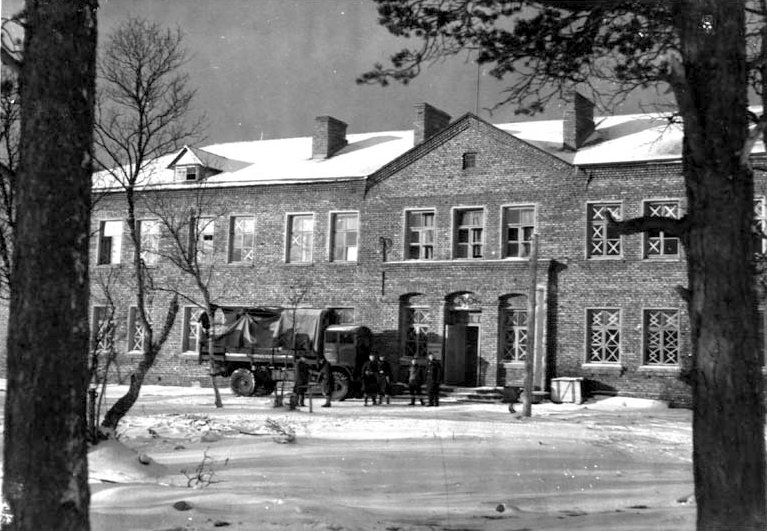
The ‘Kremlin’ as it was called was the only brick structure in the area and was the headquarters and accommodation for pilots/officers or the first few months 151 Wing were at Vaenga
Photo from Mark Sheppard collection(C)
Take off from HMS Argus
Back on board HMS Argus on 6th September, the pilots were given there final briefings. If there was to be any problems taking off the following day, then the whole mission might have to be abandoned as HMS Argus was extremely low of fuel.
On 7th September the pilots were awoken at 0200. There were problems with fog and the captain had already turned around to get back into clear sea so the Hurricanes could take off. It still meant they had to fly through the fog towards Russia.
The first six Hurricanes of ‘A’ Flight, 134 Squadron were taken on deck and assembled. At the end of the 400′ runway was a 3 foot high wooden ramp used for the Queen Bee aircraft. A lot of the pilots were quite nervous as this was there first carrier take off and to reduce weight, only six Browning Machine guns were fitted.
The ramp at the end was also causing a bit of consternation as well. S/Leader Miller in the first Hurricane took off at 0700, skipped over the ramp, dropped and flew off. Next was F/Lt V Berg O/C ‘A’ Flight in Z5206. Speeding down the flight deck he hit the ramp and damaged his undercarriage and was unable to retract. Sgt B Campbell in BD823, one of the Australians was next and he also damaged his undercarriage. The next three pilots of ‘A’ Flight took off with no further problems. Following this six came the 6 Hurricanes of ‘B’ Flight, 134 Squadron, then 6 of ‘A’ Flight, 81 Squadron and finally 6 of ‘B’ Flight 81 Squadron. By 08.15 all the Hurricanes were off on there flight to Vaenga, 15 miles NW of Murmansk.
The problems did not end there, at this Latitude the magnetic compass did not work very well so a destroyer was laid off and pointed the Hurricanes in the direction on Vaenga. The cloud was very low with mist and the flight was at sea level. After about half an hour they flew out into bright sunshine. Twenty minutes later a dark smudge appeared on the horizon which was Russia and little while after that they were circling the airfield at Vaenga. Vaenga was already a well established airfield, even if was only a scraped and flattened area within hilly areas. Flight time was about 70 minutes. The two Hurricanes with the damaged undercarriage were already sitting on there bellies; not a good impression for the Russians but both would be repaired within ten days.
On 8th September, Major General A. A. Kuznetsov held a party and concert with the RAF Officers and pilots along with Heroes of the Soviet Union who had destroyed 15 or more German aircraft.[At that moment no aviator of VVS SF had got the Golden Star during the GPW. Boris Safonov was the first HSU of VVS SF, getting his first Golden Star only one week later 16 September 1941, then claiming 14 aircraft! The C.O. of 72 SAP Col. G.P.Gubanov was apparently present in the party, he had got his Golden Star after the Winter War on 21 April 1940, but it is highly doubtful whether he scored any victories at all. However, on 14 July 1941 Gubanov, Safonov, Sn.Lt. S.I.Uvarov, Lt. D.A.Reutov, Jn.Lt. V.S.Adonkin and Sgt. V.A.Bogatyrenko had been awarded the Red banner Order. – Could possible the “Vodkaitis” disease have caused the British to see multiple Heroes during the party?- comments by C-F. Geust] The party numbered 150 and so many toasts were given with vodka and champagne that the casualties soon mounted. The Medical Officer S/Leader R Jackson put it down to ‘Vodkaitis’!!
On 9th September the unit was still not operational, a good job considering the number of empty seats at breakfast. They would be able to get there revenge with another party later.
Additional guns, ammunition and oil were delivered to Murmansk by Russian destroyers and forwarded to Vaenga. Unfortunately the guns had been forwarded without sears and without fire/safe mechanism attached. To get the wing operational two Hurricanes from each flight were stripped of eight guns and these were then fitted to four others Hurricanes ensuring that each had eight guns apiece.
Operations Commence
It was also during this time that the unusual markings on the fuselage were added The Russian Air force units only used a numbering system and not letters. After detailed research it has been discovered there was a logical number sequence and also certain numbers seem to have been applied to S/Leader and Flight commanders. ‘A’ Flight, 134 Squadron, were given numbers in the 20’s; ‘B’ Flight, 134 Squadron were given numbers in the 30’s. The same applied to 81 Squadron. ‘A’ Flight were given numbers in the 40’s and ‘B’ Flight in the 50’s. The Hurricanes at Vaenga were given the first numbers in the sequence and later when the additional Hurricanes flew up from Keg Ostrov, Archangel, these were then added onto the list using the next available number.
The Squadron letters were not removed completely as the RAF pilots and ground crew also had to identify there own aircraft. Instead of deleting the whole Squadron code, the first squadron letter was retained and the aircraft letter was reapplied next to it. The area where the aircraft letter resided was painted over and applied with the new number.
On 11th September a front line patrol was carried out by all eight aircraft of both squadrons. Each flight of four aircraft were escorted by a Russian pilot in a I-16 (?) who took them over the Front line and area of operations that they would be operating in the forthcoming weeks.
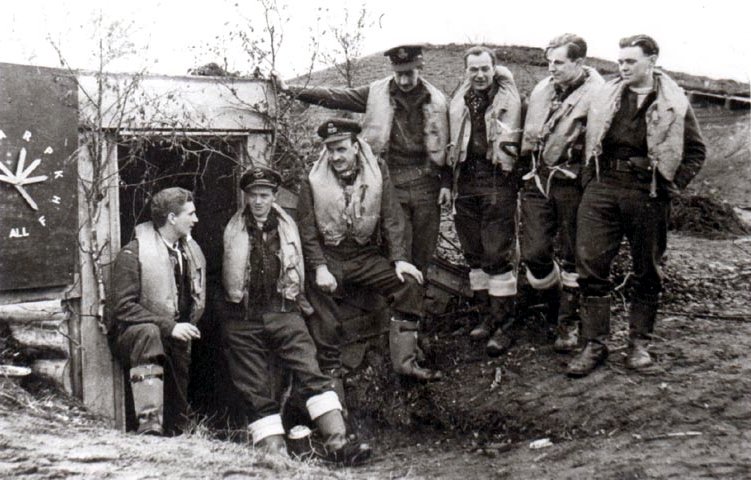
Pilots of 81 Sqn at the shelter. On the left is the indicator board showing that
Hurricanes R, P, K, and F, are armed and ready for use
Photo from Mark Sheppard collection(c)
A couple of pilots, namely P/O N. Cameron and F/Lt V. Berg had problems with engine cutting out and then restarting. On returning to base, both engines were tested with no fault found and it was put down to the low octane fuel used by the Russians. It was something that British and Russian engineers were already trying to sort out.
On 12th September the first meeting with aircraft of Luftflotte 5, based in Norway, occurred. Visibility was very good and the first operations were taken by three Hurricanes of 134 Squadron. They sighted Luftwaffe bombers but failed to make contact. Later two Hurricanes of ‘B’ Flight, 81 Squadron in the form of P/O B Bush in Z5122 and P/O J Edmiston in Z5227 were on patrol. Whilst flying over the front line they came on head to head with a twin engine fighter. Not sure immediately if it was a Bf110 or the Russian Pe-2 which had the same form, the answer was immediate when it banked and dived away and the lower crosses and yellow theatre markings became completely visible. P/O Bush scored hits on the underside and both Hurricanes chased the 110 down to tree top height with ‘Bas’ exchanging shots with the rear gunner of the Bf110 until it gradually pulled way. It is thought to have belonged to the Zerstorerstaffel I(Z)JG77.
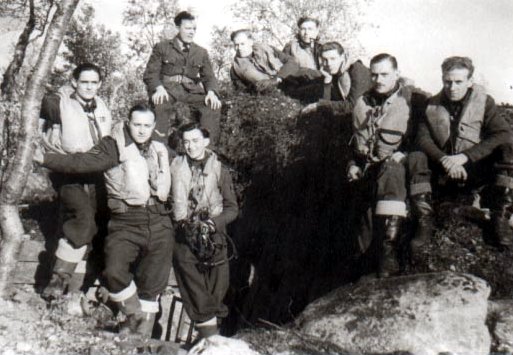
Pilots of 134 Sqn outside the shelter at Veanga in September 1941
Photo from Mark Sheppard collection(c)
Later on in the afternoon, most of the pilots had gone to the Mess for lunch leaving six 81 Squadron pilots on standby, three from each flight. A scramble was called saying bandits were over Petsamo and to look out for Russian Flak bursts.
The pilots (three from each of ‘A’ and ‘B’ Flts) were ‘A’ Flight Section Leader F/Sgt C Haw in Z4018, P/O J Walker in Z5157, Sgt K Waud in Z4006, ‘B’ Flight consisting of Sgt B Rigby in Z5207 and Sgt N Smith in Z3746.
The section were ordered to fly due West towards Petsamo (in Finland!) were bandits were reported in the area. Managing to get in the air, F/Sgt Haw noticed the formation was only five, one having failed to take off. They headed West and at 5,500 feet with the sea on the starboard they noticed the black puffs of Russian flak and five black dots.
The aircraft were five Bf109E’s of I/JG77 escorting a Hs126 of 1/(H)32. In the ensuing combat three Bf109s were destroyed and the Hs126 was damaged. The Russian Observer Corp confirmed(!!) the Hs126 as crashing and it was given as a confirmed ‘kill’ even though Luftwaffe records now show it returned to base with 30% damage and only two of the Bf109E’s is confirmed in the Luftwaffe records. This is not to say the Luftwaffe records are 100% correct as it thought, inaccurate returns were sometimes sent in. The RAF casualty was Sgt N. Smith who was seen to have suffered damage behind the cockpit. Unable to bail out because the canopy rail was damaged, it is thought he attempting a crash landing on the inhospitable terrain and was subsequently killed. He was to be one of only two RAF pilots to be killed in action during WWII whilst operating from Russian soil and was buried in ‘Cemetery of Soviet Heroes’, overlooking Murmansk Sound.
The next combat was on 17th September when eight Hurricanes of 81 Squadron were on defensive patrol at 1830pm escorting some Russian bombers back from there target. Whilst over Balucha, NW of Murmansk the escort was bounced by two Bf109E’s. At 1855pm S/Leader A. Rook in BD792 opened fire as a Bf109E passed ahead and glycol poured from it. Chasing it for five minutes S/Leader Rook ran out of bullets, Sgt P Sims in Z5228 and Sgt A Anson in Z5207 gave chase and eventually the enemy’s aircraft engine caught fire and the Bf109 crashed besides a lake.
Meanwhile the second Bf109E was being chased by F/Sgt C Haw in Z5208 as it passed ahead. Gradually F/Sgt Haw was having an effect with smoke started pouring out from the engine and on the last attack a large piece flew off and the Bf109 went into a vertical dive. The pilot baled out and was reportedly captured.
A little later at 19.15 six more Bf109E’s dived on the Russian bombers and escorts and P/O B Bush in Z4017 turned port and gave chase to the outside Bf109E. A dog fight ensued and P/O Bush was able to out turn the enemy aircraft and open fire. Thick black smoke poured from the aircraft and it crashed into a hill. The Russian bombers and Hurricanes returned safely and three Bf109E’s were confirmed as destroyed.
Over the next week only five defensive patrols were flown by both squadrons and no bomber escorts, mainly due to adverse weather conditions. The airfield was much waterlogged, with taxiing areas at 134 Squadron’s dispersal being 90% under water. It was during this period that two Hurricanes of 134 Squadron were damaged with broken propellers and others had damaged flaps from running through sandy puddles.
The next bomber escort was on 24th September when a bomber escort operation was carried out. An encounter with the Luftwaffe was to come a few days later.
On the 25th September one of 81 Squadron spare Hurricanes was presented to Major General Kuznetsov. The Hurricane Z5252 was devoid of RAF markings and instead had been painted over with Russian stars and the number ’01’ painted on the side. The General with many thousands of flying hours to his credit flew the Hurricane with no problems encountered.
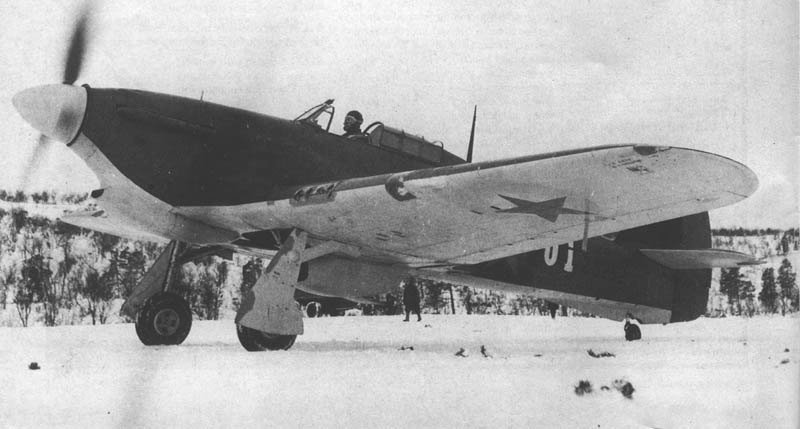
Hurricane O1 Z5252 which was presented to Major-General A A Kuznetzov, Soviet commanding officer in the region
Photo from Mark Sheppard collection(c)
On 26th September six Hurricanes from each flight of 81 Squadron were escorting 4 Russian bombers each over enemy lines. The formation was bounced by three Bf109F’s opened up from a distance and saw cannon shells going past them. (As the first recorded F were not until Feb 1942, these are thought to have been E7’s with the pointed spinners). P/O Holmes and P/O Edmiston took evasive action and saw a Bf109 on the tail of P/O Bush. P/O Holmes in BD818 gave chase and opened fire. The Bf109 belched black smoke, rolled and dived inverted, smoke still pouring from it. The aircraft was confirmed as crashing by a Russian bomber crew. Later, P/O Edmiston in Z5227 saw another of the Bf109 on the tail of another Hurricane and also gave chase opening up and hitting below the cockpit. The Bf109 turned to the left and entered cloud and was given as probable.
During the initial attack ‘B’ Flight leader F/Lt M. Rook in BD697 and Sgt V. Reed in Z4006 got separated from the rest of the flight. Flying West, the two then got bounced by a lone Bf109, firing and pulling up steeply. Sgt Reed immediately climbed and the Bf109 turned and came head on and he fired a two second burst. Giving chase he fired twice more and the Bf109 stopped taking evasive action and went into a dive. Although not confirmed at hitting the ground, the aircraft entered cloud vertically at 450mph and would not have pulled out and was confirmed as destroyed by the Russian Observer Corp. All the Hurricanes then returned to base with two confirmed kills and one probable.
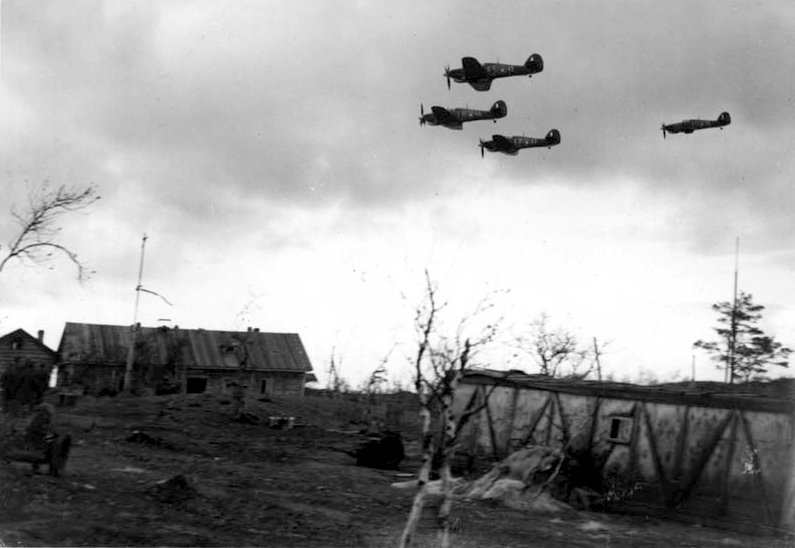
Hurricanes FS-45, FR-44, FP-43 and FU-56 of 81 Sqn returning from an escort mission
Photo from Mark Sheppard collection(c)
134 Squadron were also undertaking bomber escorts and patrols and were not having the same luck. They were also the squadron tasked with teaching the Russian pilots on the Hurricane. The first two Russian pilots were Safonov and Kuharenko. Safonov was an ace already awarded the hero of the Soviet Union title on 16 September, the highest award. He was killed on 30 May 1942 whilst flying a Lend -Lease P-40E and awarded the second Gold Stat (HSU) posthumorously on 14 June 1942.
The next encounter was on 27th September when two sections of Hurricanes, seven from ‘A’ flight and 5 from ‘B’ Flight, 81 Squadron were escorting four Russian bombers. At midday ‘A’ Flight with four Russian bombers were attacked by four Bf109E’s. The leader of the first pair tried to fire at F/Sgt Haw in Z4018 but turned towards him. After chasing around a circle, Haw eventually got on the tail of the Bf109 and opened fire. The Bf109 came out of the turn, climbed and stalled and went into a spin, white and black smoke pouring from it and the aircraft was confirmed as destroyed by the Russian Observer Corp.
At the same time two Bf109’s were attacking ‘B’ flight and its four Russian bombers. F/Lt M Rook in BD697 and his wingman P/O Edmiston in Z5227 gave chase and climbed above one of the Bf109’s. P/O Edmiston opened fire and the hood came off and the aircraft went into an uncontrollable spin. F/Lt Rook also noticed this and the aircraft was confirmed as destroyed by the Russian Observer Corp.
It was also on this day that F/Lt V. Berg of 134 Squadron was involved in a terrible accident. Due to the condition of the taxiways, the Hurricanes now had two ground crew members laid across the plane’s tail to keep it down, mainly due to the number of incidents of broken propellers. Something happened that F/Lt Berg in BD825 took off with the ground crew still on board. Unable to get off because of the slipstream, the Hurricane became airborne, stalled at about 50 feet and crashed to the ground. Both ground crew members were killed instantly and F/Lt Berg sustained serious injuries that were to stop him flying for two years. Due to this P/O N. Cameron took over command of ‘A’ Flight 134 Squadron. (P/O Neil Cameron was to go on and become Marshall of the Air Force, the highest rank a RAF Officer can go).
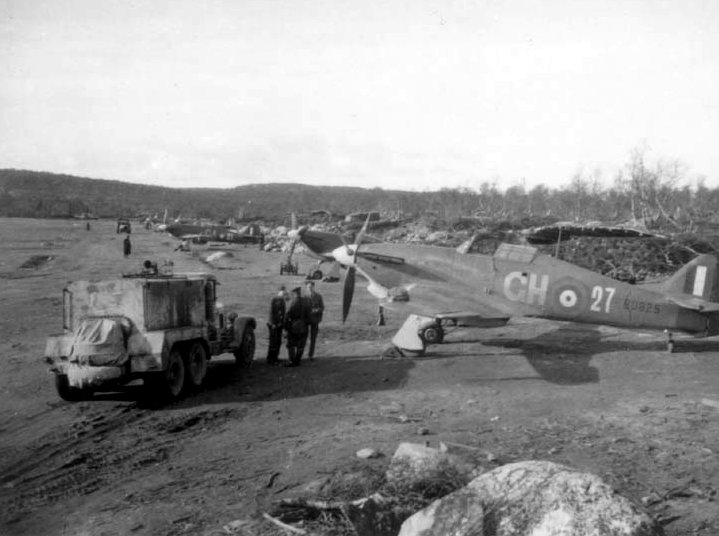
BD825 GH-34 of 134 Sqn. This aircraft was being flown by F/Lt Vic Berg when he crashed on the 27th September 1941 killing two ground crew members
Photo from Mark Sheppard collection(c)
On 29th September six Hurricanes of 134 Squadron ‘A’ flight undertook top cover for a Russian Destroyer that was shelling the coast while six Hurricanes of 134 Squadron ‘B’ flight undertook a bomber escort. During the bomber escort, one Pe-2 bomber was shot down by AA from a Russian Destroyer, although the crew managed to bail out.
By the end of the month 81 Squadron had seventeen Hurricanes on strength although a number still were not operational owing to missing gun parts. Very little occurred for the following week: very few patrols were undertaken and no bomber escorts dispatched due to bad weather.
The most memorable occurrence happened on the 6th October. At 1500 it was reported that a force of Ju88’s had left there base at Banak in Norway and were heading there way, although no one seems to have taken any notice. A number of Hurricanes were already flying locally, and a number of Hurricanes were ordered to patrol a line for bombers heading towards Murmansk. Six Hurricanes of ‘A’ flight, 134 Squadron spotted the Ju88’s at 10,000 feet in 6/10 cloud and were not attacked.
At 1550 most Hurricanes were to take to the air and S/Leader Rook was leading eight Hurricanes to locate the Ju88’s. A few minutes later the airfield AA fire opened up as a force consisting of 14 Ju88’s of I/KG30 attacked Vaenga for a mid afternoon raid on the airfield and the ground began to shake from bomb blasts. Seeing the flak the Hurricanes of 81 Squadron turned back towards the airfield and the three ‘B’ Flight pilots who were standing by on the ground decided it was better to get airborne. P/O Bush in Z3977 and P/O Holmes in BD818 managed to get off the ground but the last pilot, 20 year-old birthday boy P/O Edmiston in Z5227 was caught out. He was about to get airborne when a bomb landed in front of him stopping his engine. He then got on the wing and was promptly blown of by another bomb going off nearby, landing in a wet puddle but none the worse for wear. A trolley arc was brought out in the bombing but was unable to get it started and the pilot and ground crew took cover while Z5227 sat abandoned in the middle of airfield.
Meanwhile all the Hurricanes were now laying into the Ju88’s that were at between 7,000-10,000 feet. One Ju88 was destroyed by two 134 Squadron pilots, P/O J. Elkington in Z5236 and Sgt B. Barnes in Z5120 and another by S/Leader A. Rook of 81 Squadron in BD792 and P/O R. Furneaux of 134 Squadron in Z5253. A number of probables were also claimed. P/O Furneaux shared one with P/O D. Ramsay of 81 Squadron in Z5157 and P/O Ramsay also shared another with S/Leader A. Miller of 134 Squadron in Z5205. Two other 81 Squadron pilots had probable claims, P/O A McGregor in Z5228 and P/O J Walker in Z5209. Five other Ju88’s were claimed as damaged. Of course a number of these claims are duplicated, although there is no way of knowing the true figures. Two Ju88’s crash landed behind enemy lines and two surviving crew members from one were seen to crawl out of the wreckage: They were captured and interrogated. Another Ju88 crash landed at Petsamo and was a total loss. (All confirmed by Luftwaffe Records).
F/Lt M. Rook who was flying as a weaver to the main group of Hurricanes, split off when the squadron went after the Ju88’s. After going for a Ju88 he saw a group of 6 aircraft ahead of him, he thought were Hurricanes of 134 Squadron, as he tried to join up with them. Waggling his wing in recognition, he was rudely brought to his senses when one pealed off and with its yellow nose coming towards him, opened fire. F/Lt Rook had actually tried to join up with 6 Bf109E’s of I/JG77 that were suppose to be escorting the Ju88’s, although they seem to have been late. F/Lt Rook in Z5207 returned fire and destroyed the Bf109 and was then chased at low level by four Bf109’s right up until he was nearly home. F/Lt Rook noted this was the most difficult dog fight he had ever been in and had to sit in his cockpit until he felt able to get out safely.
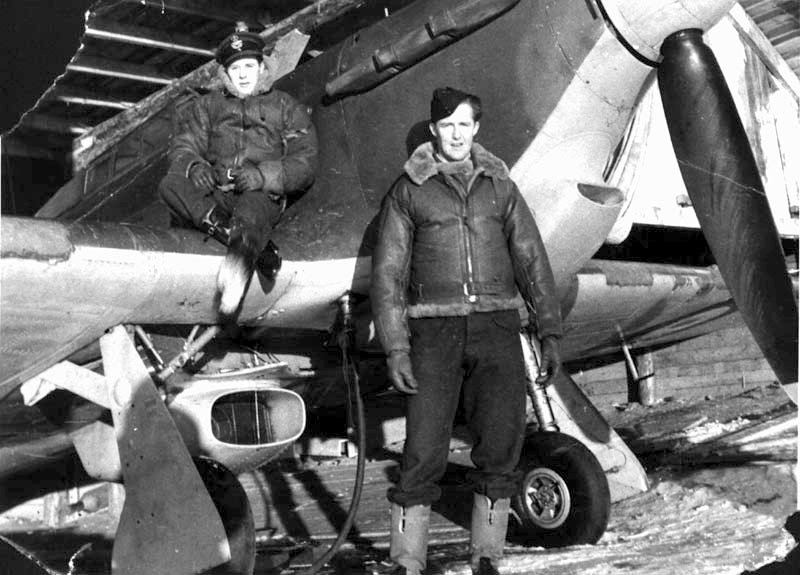
P/O Edmiston (on wing) and P/O Sheldon (standing) with a Hurricane in one of the hangers.
Note the Hurricane has a tropical filter
Photo from Mark Sheppard collection(c)
By 1630 the Hurricanes began returning to Vaenga. The airfield had been bombed with about 20 bombs going off on the airfield or around it. Most were small either 100 or 200Ib although 500 and 1000Ib had been dropped. Luckily the damage was very light.
Only one ground crew member was slightly injured and only a small amount of damage was done to some of the 81 Squadron Hurricanes. It was put down as:
Z3977 had a bullet through the windscreen and four dents in the fuselage
BD818 and Z5207 each had a bullet through the fuselage
Z5227, that sat out in the middle of the airfield during the bombing, only had a piece out of the plane’s tail.
The raid of the 6th October was really the last encountered with the Luftwaffe. A further patrol was carried out by 81 Squadron on the 8th October but with the weather deteriorating along with the hours of daylights, this was really the last one.
Whilst 81 Squadron had stopped operations, 134 Squadron were still teaching the Russian pilots about the Hurricane and undertaking bomber escorts.
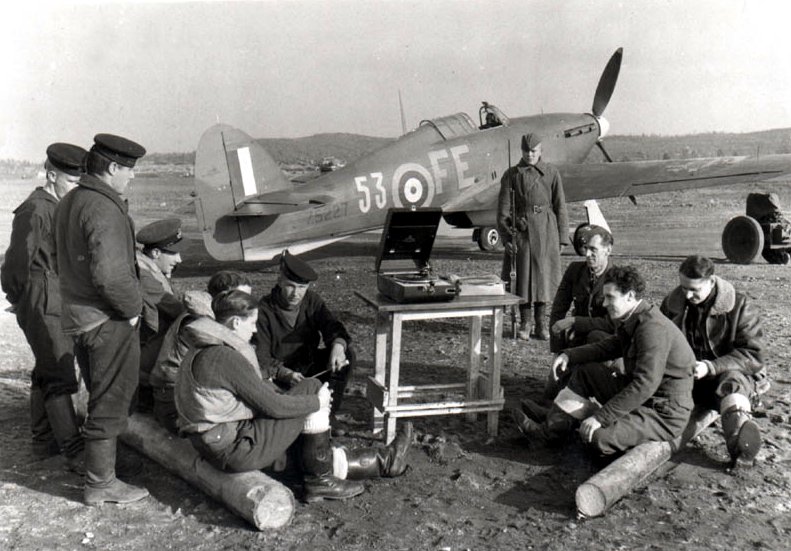
Pilots of 81 Sqn sit around playing cards and listening to a gramophone. In the back is Hurricane Z5227 FE-53 often flown by P/O Edmiston. This Hurricane was recovered in 1994 and is now with an American Collector
Photo from Mark Sheppard collection(c)
On the 13th October the Russians started to take over the Hurricanes of ‘A’ Flight 81 Squadron: ‘B’ Flight’s were to follow on the 22nd.
On the 17th October pilots of the 81 Squadron were scrambled in the 134 Squadron Hurricanes. On the 18th all of 134 Squadron Hurricanes were handed over to the Russians. The surviving 36 Hurricanes from the 39 Hurricanes of 151 Wing were to become ‘No1 Hurricane Squadron’.
The Farewell
On the 23rd October another party was organized, this time by the Wing as a farewell to their Russian hosts. The Wing stores consisted of whiskey, gin and port (beer was too bulky). Fifty guests were there, included two Heroes of the Soviet Union (Gubanov and Safonov?). This time the Russians suffered at the hands of the Wing and whereas they might be used to vodka, they could not cope with the whiskey. One officer even had a stripe removed having been seen by a Commissar, even though so many were ‘under the weather’!
On the 26th October the first Luftwaffe aircraft, a Bf110 was destroyed by an Ex-151 Wing Hurricane flown by a Russian pilot.
On the 28th October the Russian unit formed ‘No1 Hurricane Squadron’ and although involved in combat was also an OTU. A little later it became four full Russian regiments and were recognized as 72, 78, 152 and 760 IAP
[152 and 760 IAP belonged to the VVS of the Karelian Front opposing mainly the Finnish AF,while 72 and 78 IAP were naval air regiments – C-F. Geust]
On the 31st October the first Soviet assembled Hurricane shot down a Ju88 over Rybachiy Peninsula. Already over a hundred Hurricanes had arrived with the first convoys.
For the next month, very little occurred. The weather was cold and the pilots had no aircraft. It was only on the 13th November 1941 that the Wing found out it was going to be returned to the UK by sea. Up until that point there were discussions about going across Russia to the Middle East.
On the 16th November an advanced party left for Archangel to be embarked upon merchant vessels, principally the ‘Empire Baffin’.
On the 20th November it was announced that the W/Cdr and S/Leaders Rook and Miller as well as F/Sgt Haw were to be awarded ‘The Order of the Red Banner’.
During this week the Wing was split up and embarked upon HMS ‘Kenya’ and HMS ‘Berwick’, both cruisers and the destroyers HMS ‘Bedouin’ and HMS ‘Intrepid’. Further members of the advance party joined the Merchant ships ‘Empire Baffin’ and ‘Harpolian’. HMS Kenya was to leave first and arrived back in Rosyth on the 7th December 1941.
On the 28th November the awards to the W/Cdr, two S/Leaders and F/Sgt Haw were announced as the ‘Order of Lenin’, Russia’s highest award. The engineering Officer F/Lt Gittins who did a marvelous job assembling the 15 Hurricanes would also be awarded an’ Order of the Red Star’ in 1944.
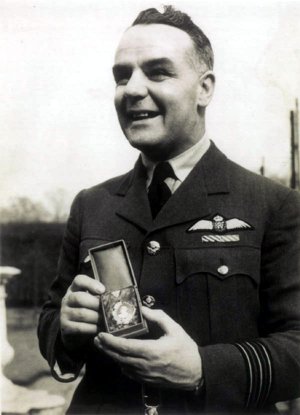
W/Cdr (later) G/Cpt H N G Ramsbottom-Isherwood (NZ) AFC DFC in March 1942 having been awarded the Order of Lenin in London by Russian Ambassador Mayski in London
Photo from Mark Sheppard collection(c)
From this short expedition, the Squadron badges were embellished to commemorate the Squadrons’ activities in Russia: 81 Squadron, having a red star in the centre and 134 gauntlet colored in red, the gauntlet having carried over from 17 Squadron days.
The Wing HQ went to RAF Ouston and was basically split up. 81 Squadron went to RAF Turnhouse, Edinburgh and re-equipped with Spitfire V and 134 Squadron went to RAF Catterick re-equipping with Spitfires V and moving to Northern Ireland.
This was not nearly the end of it. A year later 153 Wing was formed on the 5th July 1942 at Debden with G/Cpt Ramsbottom Isherwood AFC DFC, W/Cdr Rook DFC, W/Cdr Miller DFC, S/Leader Jackson – Medical Officer, for a return visit with a larger force. This force was code named ‘Invective’ and would have meant sending four squadrons of Spitfires from the Debden Wing and two Squadrons of Hurricanes. The 2000 personnel and 96 aircraft would have had to go by ship to Murmansk.
This was unfortunately cancelled on the 20th July 1942 most probably due to the increasing convoy casualties. It was not worth the possible loss of the whole wing. Lend lease aircraft were expendable, not 2000 RAF pilots, ground crew, and other personnel.
The author would still like to hear from any Ex-151 Wing members he has not yet been able to locate, especially the Wing Officers.
